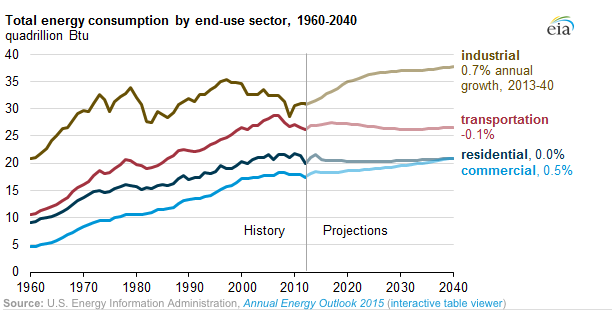Energy consumption in the U.S., which has slowed recently, is projected to inch up by only 0.3% per year through 2040, which would be less than half the projected population growth rate over that period.
In its Annual Energy Outlook 2015, the U.S. Energy Information Administration (EIA) elaborates that industrial energy consumption over the next 25 years will be slightly higher, at 0.7% per year, while annual commercial consumption is expected to be 0.5%.
EIA attributes these consumption reductions to the adoption of energy efficient technologies, as well as “larger structural changes in the economy.” For example, residential consumption has slowed as more people have moved to warmer climates. And policies that have mandated better fuel efficiencies in cars and trucks appear to be having a positive effect.
“These standards, combined with less travel in response to technological and social factors, have reduced transportation energy consumption in recent years and are expected to continue holding transportation consumption nearly flat in the coming decades,” EIA observes.

The department points to several factors that are expected to shape U.S. energy markets in the next generation. These include:
- Growth in U.S. energy production, coupled with only modest increases in domestic demand, will further reduce the country’s reliance on imported energy suppliers. EIA anticipates that energy imports and exports “come into balance” in the U.S. starting in 2028.
- The U.S. will transition from being a modest net importer of natural gas to a net exporter by 2017, with net exports in 2040 ranging from 3 trillion cubic feet (in a low-oil-price scenario) to 13.1 million (in a high oil and gas resource scenario).
- Rising costs for electric power generation, transmission, and distribution, along with slower growth in electricity demand, are expected to lead to an 18% increase in the average retail price of electricity between 2013 and 2040.
- End-user efficiencies are expected to keep energy related carbon dioxide emissions in the U.S. below 2005 levels through 2040.
EIA expects net energy exports to contribute more to the country’s GDP growth than it has in the previous 30 years, partly because of reduced imports. But that impact is also expected to diminish in the later years of this projection cycle, as GDP growth in nations that are U.S. trade partners slows.
Related Stories
| Aug 11, 2010
SSOE, Fluor among nation's largest industrial building design firms
A ranking of the Top 75 Industrial Design Firms based on Building Design+Construction's 2009 Giants 300 survey. For more Giants 300 rankings, visit http://www.BDCnetwork.com/Giants
| Aug 11, 2010
Best AEC Firms of 2011/12
Later this year, we will launch Best AEC Firms 2012. We’re looking for firms that create truly positive workplaces for their AEC professionals and support staff. Keep an eye on this page for entry information. +
| Aug 11, 2010
Report: Building codes and regulations impede progress toward uber-green buildings
The enthusiasm for super green Living Buildings continues unabated, but a key stumbling block to the growth of this highest level of green building performance is an existing set of codes and regulations. A new report by the Cascadia Region Green Building Council entitled "Code, Regulatory and Systemic Barriers Affecting Living Building Projects" presents a case for fundamental reassessment of building codes.
| Aug 11, 2010
Portland Cement Association offers blast resistant design guide for reinforced concrete structures
Developed for designers and engineers, "Blast Resistant Design Guide for Reinforced Concrete Structures" provides a practical treatment of the design of cast-in-place reinforced concrete structures to resist the effects of blast loads. It explains the principles of blast-resistant design, and how to determine the kind and degree of resistance a structure needs as well as how to specify the required materials and details.
| Aug 11, 2010
ZweigWhite Announces 2009 Best Firms to Work For
Management consulting and research firm ZweigWhite has identified the best civil engineering, structural engineering, multidiscipline A/E services, environmental services, and architecture firms to work for in its annual ranking of top industry firms. These outstanding employers were selected based on their commitment to provide a positive work environment and challenging and interesting work opportunities for their employees.
| Aug 11, 2010
Autodesk 2010 Certification Now Available for Design Professionals
Autodesk, Inc., (Nasdaq: ADSK), today announced that design and engineering professionals can become Autodesk Certified in AutoCAD 2010, Autodesk Inventor 2010, Autodesk Revit Architecture 2010, and AutoCAD Civil 3D 2010 software. Becoming Autodesk Certified allows professionals, and companies boasting Autodesk Certified employees, to validate their industry skills and knowledge, demonstrate expertise and gain credibility.







